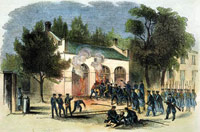Foundations of U.S. History, Virginia History as U.S. History features 4th graders learning about John Brown's raid on Harpers Ferry through analyzing the song "John Brown's Body." Video clips of classroom instruction accompany short videos of a scholar analyzing the song and the teacher reflecting on the lesson. The John Brown song is one of eight documents found on the Source Analysis feature of the Teaching American History grant website in Loudoun County, Virginia. In the classroom practice section for John Brown's Body we see students analyzing the song to understand how northerners viewed John Brown shortly after his raid on Harpers Ferry. This video provides examples of two promising practices:
- Close analysis of a song as a primary source
- Consideration of whether views expressed in that source represent all perspectives.
The Lesson in Action
The lesson starts with the teacher playing the song "John Brown's Body." In this warm-up activity, the teacher instructs students to draw a picture of "what you see in your mind." After students share their drawings, the teacher provides them with a worksheet to help students analyze the musical composition. Next, students analyze the lyrics to an adapted version of the song written in 1861. The teacher works with individual students to help them use prior knowledge to make sense of the song and generate questions about the song. This progression from open-ended student task to close historical analysis engages and challenges students.
Students see that while primary documents are valuable evidence, they should not assume that an individual source speaks for all people.
Towards the end of the lesson, the teacher facilitates a whole-class review of the Guiding Question worksheet. After students share that they think the song portrayed John Brown as a hero, the teacher refers back to a prior lesson asking, "Do you think this song represents how everybody in the North feels?" Students respond that it does not. The teacher uses this conversation as an opportunity to review that many people in the North did not support John Brown's tactics. Students see that while primary documents are valuable evidence, they should not assume that an individual source speaks for all people. This lesson also draws on multiple classroom resources and incorporates a variety of historical thinking skills. Students use their textbook to help them make sense of the song: they consider the song's historical context and audience. Additionally, you can find a comprehensive lesson plan, complete with additional primary sources, background information, and classroom worksheets, on the site.

